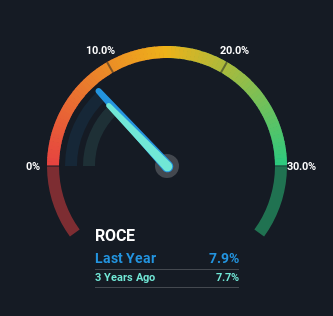
There are a few key trends to look for if we want to identify the next multi-bagger. In a perfect world, we'd like to see a company investing more capital into its business and ideally the returns earned from that capital are also increasing. Ultimately, this demonstrates that it's a business that is reinvesting profits at increasing rates of return. However, after investigating Taiyo Koki (TSE:6164), we don't think it's current trends fit the mold of a multi-bagger.
Return On Capital Employed (ROCE): What Is It?
Just to clarify if you're unsure, ROCE is a metric for evaluating how much pre-tax income (in percentage terms) a company earns on the capital invested in its business. Analysts use this formula to calculate it for Taiyo Koki:
Return on Capital Employed = Earnings Before Interest and Tax (EBIT) ÷ (Total Assets - Current Liabilities)
0.079 = JP¥554m ÷ (JP¥8.8b - JP¥1.8b) (Based on the trailing twelve months to December 2023).
Therefore, Taiyo Koki has an ROCE of 7.9%. On its own that's a low return on capital but it's in line with the industry's average returns of 7.9%.
Check out our latest analysis for Taiyo Koki

While the past is not representative of the future, it can be helpful to know how a company has performed historically, which is why we have this chart above. If you're interested in investigating Taiyo Koki's past further, check out this free graph covering Taiyo Koki's past earnings, revenue and cash flow.
So How Is Taiyo Koki's ROCE Trending?
When we looked at the ROCE trend at Taiyo Koki, we didn't gain much confidence. Over the last five years, returns on capital have decreased to 7.9% from 31% five years ago. However, given capital employed and revenue have both increased it appears that the business is currently pursuing growth, at the consequence of short term returns. And if the increased capital generates additional returns, the business, and thus shareholders, will benefit in the long run.
In Conclusion...
In summary, despite lower returns in the short term, we're encouraged to see that Taiyo Koki is reinvesting for growth and has higher sales as a result. These trends are starting to be recognized by investors since the stock has delivered a 32% gain to shareholders who've held over the last five years. So this stock may still be an appealing investment opportunity, if other fundamentals prove to be sound.
One more thing: We've identified 2 warning signs with Taiyo Koki (at least 1 which is potentially serious) , and understanding these would certainly be useful.
While Taiyo Koki isn't earning the highest return, check out this free list of companies that are earning high returns on equity with solid balance sheets.
Valuation is complex, but we're here to simplify it.
Discover if Taiyo Koki might be undervalued or overvalued with our detailed analysis, featuring fair value estimates, potential risks, dividends, insider trades, and its financial condition.
Access Free AnalysisHave feedback on this article? Concerned about the content? Get in touch with us directly. Alternatively, email editorial-team (at) simplywallst.com.
This article by Simply Wall St is general in nature. We provide commentary based on historical data and analyst forecasts only using an unbiased methodology and our articles are not intended to be financial advice. It does not constitute a recommendation to buy or sell any stock, and does not take account of your objectives, or your financial situation. We aim to bring you long-term focused analysis driven by fundamental data. Note that our analysis may not factor in the latest price-sensitive company announcements or qualitative material. Simply Wall St has no position in any stocks mentioned.
About TSE:6164
Taiyo Koki
Develops, manufactures, and sells grinding machine tools in Japan and internationally.
Flawless balance sheet low.
Similar Companies
Market Insights
Community Narratives



